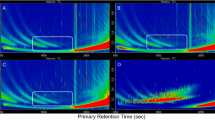Abstract
Petroleum is a complex mixture of compounds that span a wide range of chemical characteristics. Petroleum is released into the environment naturally via seepage from deep reservoirs and through anthropogenic means, including leaks from small boats, ships, tankers, pipelines, drilling infrastructure, and through accidental platform discharges or well blowouts. Hydrocarbon oxidizing bacteria play a key role in the breakdown and remineralization of petroleum introduced into the environment. A diverse array of microorganisms possess the enzymatic machinery necessary to oxidize petroleum, and in the process, obtain energy for growth, and carbon to build biomass from the cleavage of C–H bonds. However, it is notoriously difficult to quantify degradation rates of hydrocarbons. Here, we present a simple method for determining hydrocarbon oxidation rates in environmental samples, targeting two common hydrocarbons. The method can easily be adapted to assess biodegradation rates of other hydrocarbons.
Access this chapter
Tax calculation will be finalised at checkout
Purchases are for personal use only
Similar content being viewed by others
References
Tissot BP, Welte DH (1984) Petroleum formation and occurrence, 2nd edn. Springer, New York
Waples DW (1985) Geochemistry in petroleum exploration. Springer, Boston, p 223
Curiale J, Frolov E (1998) Occurrence and origin of olefins in crude oils. A critical review. Org Geochem 29(3):397–408. doi:10.1016/S0146-6380(98)00058-8
Aeppli C, Nelson RK, Radovic JR, Carmichael CA, Valentine DL, Reddy CM (2014) Recalcitrance and degradation of petroleum biomarkers upon abiotic and biotic natural weathering of Deepwater Horizon oil. Environ Sci Tech 48(12):6726–6734. doi:10.1021/es500825q
Spiro TG, Purvis-Roberts KL, Stigliani WM (2012) Chemistry of the environment, 3rd edn. University Science, Sausalito, CA
Atlas RM (1981) Microbial degradation of petroleum hydrocarbons: an environmental perspective. Microbiol Rev 45(1):180–209
Reddy CM, Areyb JS, Seewalda JS, Sylvaa SP, Lemkaua KL, Nelsona RK, Carmichaela CA, McIntyrea CP, Fenwickc J, Venturad GT, Van Mooya BAS, Camillic R (2012) Composition and fate of gas and oil released to the water column during the Deepwater Horizon oil spill. Proc Natl Acad Sci U S A 109(50):20229–20234. doi:10.1073/pnas.1101242108
Bacosa HP, Erdner DL, Liu Z (2015) Differentiating the roles of photooxidation and biodegradation in the weathering of Light Louisiana Sweet crude oil in surface water from the Deepwater Horizon site. Mar Pollut Bull 95(1):265–272
Maki H, Sasaki T, Harayama S (2001) Photo-oxidation of biodegraded crude oil and toxicity of the photo-oxidized products. Chemosphere 44:1145–1151
Aeppli C et al (2012) Oil weathering after the Deepwater Horizon disaster led to the formation of oxygenated residues. Environ Sci Tech 46:8799–8807
Reddy CM, Eglinton TI, Hounshell A, White HK, Xu L, Gaines RB, Frysinger GS (2002) The West Falmouth oil spill after 30 years: the persistence of petroleum hydrocarbons in salt marsh sediments. Environ Sci Tech 36:4754–4760
Liu Z, Liu J, Zhu Q, Wu W (2012) Oil spill: insights from the chemical composition of the oil from the sea surface, salt marshes and sediments. Environ Res Lett 7(3):035302
White HK et al (2012) Impact of the Deepwater Horizon oil spill on a deep-water coral community in the Gulf of Mexico. Proc Natl Acad Sci U S A 109(50):20303–20308. doi:10.1073/pnas.1118029109
Valentine DL et al (2014) Fallout plume of submerged oil from Deepwater Horizon. Proc Natl Acad Sci U S A 111(45):15906–15911. doi:10.1073/pnas.1414873111
Kleindienst S et al (2015) Chemical dispersants can suppress the activity of natural oil-degrading microorganisms. Proc Natl Acad Sci U S A 112(48):14900–14905. doi:10.1073/pnas.1507380112
Liu Y, Kujawinski EB (2015) Chemical composition and potential environmental impacts of water-soluble polar crude oil components inferred from ESI FT-ICR MS. PLoS One 10(9), e0136376. doi:10.1371/journal.pone.0136376
Seidel M, Kleindienst S, Dittmar T, Joye SB, Medeiros PM (2016) Biodegradation of crude oil and dispersants in deep seawater from the Gulf of Mexico: insights from ultra-high resolution mass spectrometry. Deep-Sea Res II Top Stud Oceanogr 129:108–118. doi:10.1016/j.dsr2.2015.05.012
Efroymson R, Alexander M (1991) Biodegradation by an Arthrobacter species of hydrocarbons partitioned into an organic solvent. Appl Environ Microbiol 57(5):1441–1447
Zengler K, Richnow HH, Rosselló-Mora R, Michaelis W, Widdel F (1999) Methane formation from long-chain alkanes by anaerobic microorganisms. Nature 401:266–269. doi:10.1038/45777
Author information
Authors and Affiliations
Corresponding author
Editor information
Editors and Affiliations
Rights and permissions
Copyright information
© 2016 Springer-Verlag Berlin Heidelberg
About this protocol
Cite this protocol
Sibert, R., Harrison, S., Joye, S.B. (2016). Protocols for Radiotracer Estimation of Primary Hydrocarbon Oxidation in Oxygenated Seawater. In: McGenity, T., Timmis, K., Nogales , B. (eds) Hydrocarbon and Lipid Microbiology Protocols. Springer Protocols Handbooks. Springer, Berlin, Heidelberg. https://doi.org/10.1007/8623_2016_227
Download citation
DOI: https://doi.org/10.1007/8623_2016_227
Published:
Publisher Name: Springer, Berlin, Heidelberg
Print ISBN: 978-3-662-53116-7
Online ISBN: 978-3-662-53118-1
eBook Packages: Springer Protocols




